September’s Birthstone: Unveiling the Splendor of Sapphire
The September birthstone is sapphire, a traditionally blue stone that also comes in virtually every color. This precious gemstone is a versatile, beloved jewel with centuries of uses and meanings.
The month of September comes from the Latin septem, meaning “seven,” because it was the seventh month in the calendar back when March started the year.
September often represents the start of autumn, a new school year, and harvesting crops. United Nations holidays in September celebrate charity, democracy, and world peace.
Today, September symbolizes abundance, service, and self-reflection.
Does the month’s birthstone reflect these ideals? Find out today as we cover the history, meanings, properties, and powers of the September birthstone sapphire. We’ll also touch on alternative September birthstones and gift ideas!
 Pictured above: Faceted colored sapphire ring
Pictured above: Faceted colored sapphire ring
Historical & Cultural Significance of September Birthstone: Sapphire
Sapphire is the main birthstone for September, but is sapphire the only birthstone for September? It’s definitely the main birthstone, but birthstones have changed over time.
The earliest birthstone lists, inspired by Biblical lists of 12 gemstones, had peridot for September and sapphire for April.
Modern formalized lists began in 1870, when Tiffany & Co published a pamphlet of birthstone poems, with sapphire for September.
The first official standardized list was created in 1912 by the American National Association of Jewellers (now Jewellers of America), followed by a 1937 list by the British National Association of Goldsmiths. Both designated sapphire for September.
However, the most recent 2013 United Kingdom list has 2 September birthstones: sapphire and lapis lazuli.
Funny enough, the word “sapphire” was originally used for lapis lazuli and other blue gemstones.
Speaking of history, let’s travel back to sapphire’s legendary past!
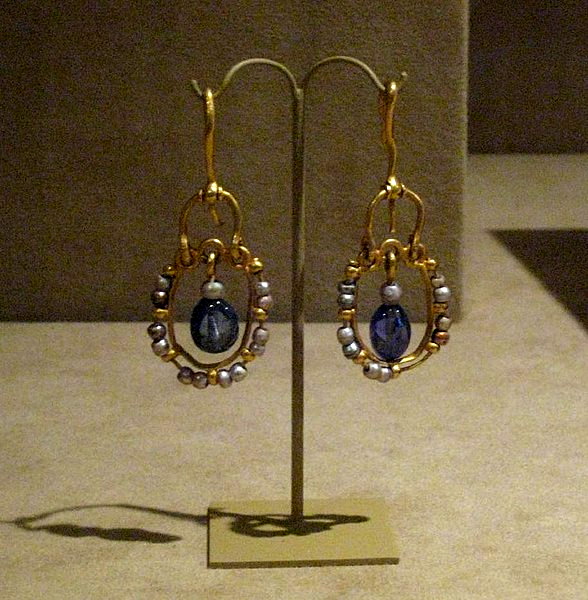 Pictured above: A pair of Byzantine (circa 500 to 700 AD) gold earrings with pearl and sapphire stones; Discovered in 1902 at Karavas, Cyprus; Now displayed at the Metropolitan Museum of Art, New York | Image credit: Unforth, Flickr, CC-BY-SA-2.0
Pictured above: A pair of Byzantine (circa 500 to 700 AD) gold earrings with pearl and sapphire stones; Discovered in 1902 at Karavas, Cyprus; Now displayed at the Metropolitan Museum of Art, New York | Image credit: Unforth, Flickr, CC-BY-SA-2.0
Sapphires in Ancient Civilizations & Mythology
The oldest known sapphire source is Sri Lanka, based on sapphire jewelry dated from 600 to 275 BC. Sri Lankans saw sapphires as celestial gifts and the mines as sacred.
An ancient Persian legend claimed Earth sat on a huge sapphire and its reflection made the sky blue. They called sapphire lazvard, meaning “having the color of clear sky.”
Sapphires were connected to the sun god Apollo in ancient Greece.
Ever heard of Prometheus, the Titan god chained to a rock while an eagle ate his liver every day? One version says the rock was sapphire, and Prometheus kept a piece of it, said to be the first sapphire gemstone, on a ring made from his chain after Hercules freed him.
Medieval clergy wore blue sapphires to represent heaven, chastity, and spiritual devotion, like the huge sapphire amulet worn by devout Roman Emperor Charlemagne.
On that topic…
Sapphires in Religious Contexts
Mentions of sapphire in Judaism and Christianity include:
Seal of Solomon: Legendary inscribed sapphire signet ring of Israelite king Solomon said to grant him supernatural powers
Ten Commandments: Fundamental principles given by God to the prophet Moses, said to be etched onto sapphire tablets in rabbinical Judaism
High Priest’s Breastplate: Sanctified “breastplate of judgment” worn by High Priest of the Israelites and adorned with 12 gems, sapphire being the fifth
New Jerusalem or Zion: Utopian afterlife society described in a prophetic vision as having twelve gem “foundation stones,” one being sapphire
Mentions of the September birthstone in Islam include:
Religious Rings: Worn traditionally by the Shi’a and Imams to indicate being a believer, inspired by the prophet Muhammad’s signet ring; Imam narrations say sapphire rings dispel poverty
Seventh Heaven: Dar-us-Salam, the level of peace, last of seven “levels” of heavenly paradise, described in the Quran as having valleys of pearls and sapphires
In Hinduism, sapphires are prominent in Vedic astrology, where certain gemstones are believed to boost the positive effects or diminish the negative effects of different planet placements in one’s birth chart.
Blue sapphire is associated with Saturn, the planet of responsibility and career. Yellow sapphire is tied to Jupiter, the planet of success and personal growth. White sapphire can substitute for diamond as a stone for Venus.
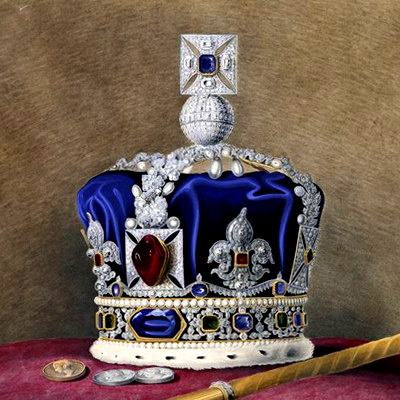 Pictured above: Hand-colored lithograph of Queen Victoria's Imperial State Crown, early-mid 19th century | Image credit: British School, Public domain
Pictured above: Hand-colored lithograph of Queen Victoria's Imperial State Crown, early-mid 19th century | Image credit: British School, Public domain
Royal Sapphire Crowns & Jewelry
Royals wearing sapphire dates back to ancient kings and queens of Rome and Greece.
Some famous examples of royal British sapphire crowns are:
Belgian (or Victorian or George VI) Sapphire Tiara: Sapphire & diamond tiara created from Princess Louise of Belgium’s necklace, purchased by Queen Elizabeth II in 1963 and converted to match George VI Victorian Suite
St. Edward’s Crown: Oldest and largest British crown, set with 444 gemstones including St. Edward’s Sapphire and Stuart Sapphire; Original crown worn by medieval king St. Edward the Confessor (with sapphire from his ring); Current version made in 1661 for Charles II (adding his Stuart Sapphire); Only worn during coronations since 1911
Imperial State Crown: Contains St. Edward’s Sapphire, part of British Crown Jewels; Made for King George VI’s coronation in 1937; Worn by new king or queen when leaving coronation and attending State Openings of Parliament
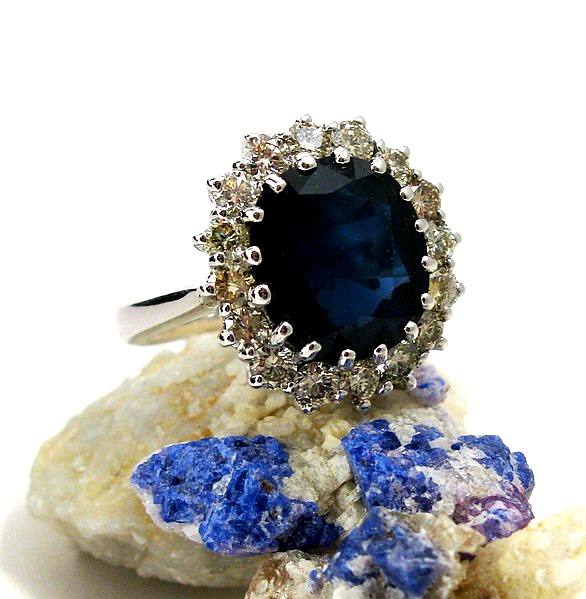 Pictured above: Replica of Lady Diana Spencer's sapphire engagement ring | Image credit: Ann Porteus from Tasmania, Australia; Flickr; CC-BY-SA-2.0
Pictured above: Replica of Lady Diana Spencer's sapphire engagement ring | Image credit: Ann Porteus from Tasmania, Australia; Flickr; CC-BY-SA-2.0
Royal Sapphire Jewelry
Some famous examples of royal British sapphire jewelry are
Prince Albert Brooch: Sapphire and diamond brooch set in gold, given to Queen Victoria II by Prince Albert in 1840; Worn by Princess Diana of Wales for wedding-day “something blue” in 1981
George VI Victorian Suite: Sapphire & diamond necklace and earrings, largest sapphire later removed and made into pendant; Created in 1850 and given by King George VI to daughter Elizabeth in 1947
Princess Diana’s Choker Necklace: Sapphire & diamond clasp with 7 pearl strands; Clasp adapted from brooch given to Princess Diana of Wales by Queen Elizabeth II
Princess Diana’s Engagement Ring: Garrard ring with sapphire center stone & diamonds, inspired by Prince Albert Brooch; Presented by Prince Charles in 1981; Presented by Prince William to Kate Middleton in 2010
Speaking of engagement rings, did you know sapphires were the norm before diamonds? Popularized by nobility in the 1400-1500s, engagement rings usually had sapphire center stones until diamonds became standard.
Geological Marvel: The Formation of Sapphires
The sapphire September birthstone is a variety of the aluminum oxide mineral corundum. The other variety is ruby, both being precious gemstones. But wait, is ruby a September birthstone? Traditionally, ruby is a July birthstone.
These minerals are the second hardest after diamond, ranking at 9 on the Mohs scale.
Corundum stones form in metamorphic rocks or aluminum-rich, silica-free igneous rocks. Impurities and inclusions present during formation lead to sapphire’s varied appearances.
So, what is the September birthstone’s color?
 Pictured above: Faceted peacock / mermaid sapphire
Pictured above: Faceted peacock / mermaid sapphire
Diverse Hues: Unraveling Sapphire's Color Spectrum
Throughout history, “sapphire” has been synonymous with “blue.” However, the September birthstone’s color actually includes every hue except red — that’s ruby.
Corundum is allochromatic, so colors come from impurities. The impurities behind each shade are listed below. You can learn more about each sapphire color at the articles linked:
White – No (or minimal) impurities
Blue – Iron & titanium (more titanium means darker shades)
Pink – Chromium (small amounts)
Purple – Vanadium or combination of chromium, titanium, & ferrous iron
Yellow – Ferric iron
Orange – Chromium & iron impurities or exposure to irradiation (natural or lab-induced)’
Green – Ferric iron & ferrous iron
Black – Iron & high titanium
Brown – Iron & sometimes titanium
 Pictured above: Faceted purple sapphire
Pictured above: Faceted purple sapphire
Additionally, there are some notable varieties of this September birthstone with gorgeous appearances:
Color-Change Sapphire: Usually color-changing from blue or purple in daylight to violet or reddish-purple under incandescence
Padparadscha Sapphire: Combination of pink & orange, originally from Sri Lanka; Among rarest & most valuable types
Peacock or Mermaid Sapphires: Blue and green with 50-50 hue ratio
Bi-Colored or Parti-Colored Sapphires: Distinct colors in different sections, usually green & yellow
Star Sapphires: Display multi-rayed “star” of reflected from optical effect called asterism caused by parallel inclusion bundles of rutile or diaspore
Trapiche Sapphires: Display 6-rayed star-like pattern internally that resembles wheel-spokes due to carbonaceous inclusions setting between growth zones
Color is just one factor when grading the September birthstone’s quality.
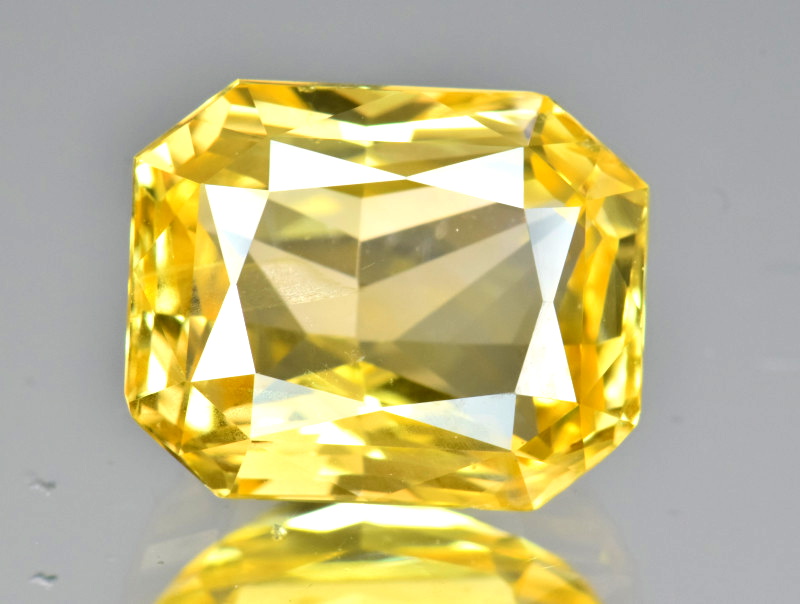 Pictured above: Faceted yellow sapphire
Pictured above: Faceted yellow sapphire
The 4 Cs: Assessing Sapphire Quality
The value of sapphire birthstones depends on the color, cut, clarity, and carat weight. Treatments and formation (synthetic vs. natural) also play a role.
Color
The top sapphire value factor is color. Blue is most popular but also most valuable, particularly cornflower blue.
Bright saturation and medium to deep tone are best. Kashmir blue, Padparadscha, and bright pink hues are most valuable. Black is least valuable.
Cut
Sapphires must be cut to maximize pleochroism, color-zoning, sparkle, size, and optical effects (if present). The most popular faceted cuts are round, oval, and cushion. Emerald, marquise, and pear shapes are more valuable.
Optically phenomenal stones like sapphires must be cut as cabochons. The stone may be carved or beaded, too.
 Pictured above: Faceted Kashmir sapphire
Pictured above: Faceted Kashmir sapphire
Clarity
Sapphires have Type II clarity, so minor visible inclusions are common, but higher value goes to stones with fewer visible inclusions. Some sapphire clarity grades follow standard diamond grading — IF for best to I3 for worst.
The best sapphires have VVS clarity, but most are VS to SI.
The exception to inclusions-lowering-value rule is when inclusions cause asterism or a velvety look (e.g. Kashmir sapphires).
Carat Weight
Different colors of sapphire September birthstones range in carat weight. Quality tends to decrease in larger sizes, so the most valuable color (blue) with good quality and high carat weight is exceptional and rare.
Price-per-carat rates will increase at each September birthstone’s size interval, and options over 5 carats are significantly pricey.
Treatments & Synthetics
Around 95 percent of sapphires are heated to improve color and clarity, so heat treatments don’t usually affect value much.
Other potential treatments include diffusion, irradiation, or flux fracture-healing. Avoid sapphire birthstones with thin-film coating, fillings, or oil treatments.
Lab-grown synthetic sapphires have gained popularity among buyers looking for more ethical or affordable gem alternatives.
Value-wise, lab-grown sapphires cost up to $10,000 less per carat than their natural counterparts.
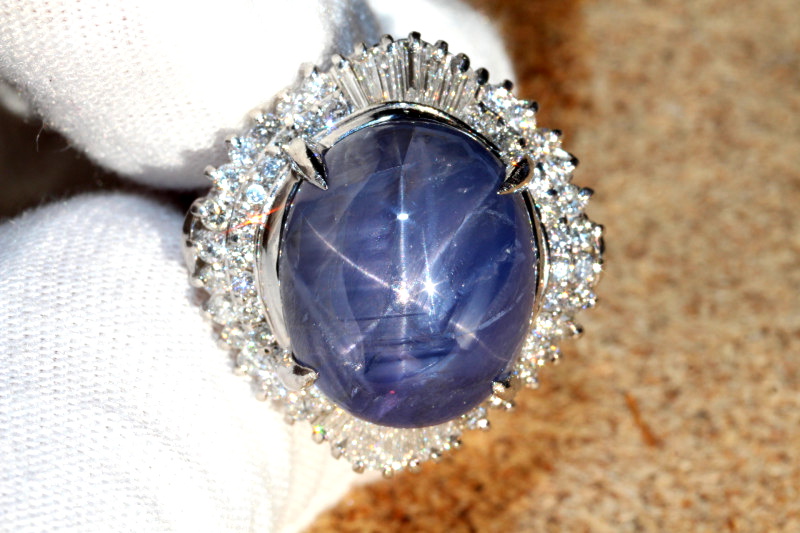 Pictured above: Blue star sapphire ring with accent diamonds
Pictured above: Blue star sapphire ring with accent diamonds
Sapphires in Symbolism and Belief Systems
Today, the September birthstone’s meaning is often one of wisdom, loyalty, and faith. (Read more about each sapphire color’s meaning in our Sapphire Info Guide.)
Some interpretations of sapphire’s meaning have been more prominent over time:
Oracles & Magic
In ancient times, priests and magicians believed sapphires helped them make and interpret predictions about the future. Ancient Greeks wore sapphire to visit the oracle at Delphi, believing the September birthstone connected them to spirits.
Alchemists, astrologers, and sorcerers also used sapphire’s magical properties, sometimes for accessing their “third eye.”
Divine Protection
Many cultures see blue sapphire as heavenly and sacred. Interpretations of its shine range from the stone not shining on corrupt wearers to dimming if one’s partner was cheating.
Another common belief is that sapphires dispel evil and attract divine favor.
Some Muslims believe blue sapphire brings its wearer success, peace, and enlightenment and protects them from curses.
Some Christians view star sapphires (pictured above) as representing faith, hope, and destiny.
 Pictured above: Blue sapphire engagement ring
Pictured above: Blue sapphire engagement ring
Marriage & Love
One nickname for sapphire is “Stone of Commitment.” September birthstone engagement rings are thought to represent fidelity and everlasting love.
One saying goes: “Married in September’s golden glow, smooth and serene your life will go.”
Already married? Sapphire is the traditional 5th and 45th wedding anniversary gem! Plus, according to The Knot, September is currently the most common wedding month.
Healing Properties
As a healing stone, some of the September birthstone’s physical powers popular over time include:
Poison antidote
Increases strength
Benefits the eyes
Boosts immune system
Fever treatment
Emotionally, sapphires are believed to be calming, boost confidence, and facilitate peace between enemies or quarreling lovers.
 Pictured above: Lapis lazuli earrings
Pictured above: Lapis lazuli earrings
Alternative September Birthstones
Sapphire isn’t the only September birthstone. Ancient birthstone lists actually designated peridot for September instead of August.
Another option for September birthstone jewelry is lapis lazuli, an opaque deep blue gem with golden speckling.
What is Virgo’s birthstone? Ruled by Mercury, September-born Virgos (before September 23) can benefit from planetary stones for Mercury like fluorite or aventurine.
What crystal is for Libra? Ruled by Venus, September-born Libras (from September 1 to 22) might love the Venus stone white sapphire. Other great Libra birthstones include ametrine, peridot, and morganite.
Personalized September Birthstone Gifts & Celebrations
Did you know September birthdays are the most common in the US? According to CDC and SSA data, September 9 takes the top spot.
Chances are, you have a loved one born in September if you aren’t a September baby yourself. If you are, you could even gift a September birthstone ring to celebrate Mother’s Day!
Other September birthstone gift ideas:
Personalized birthstone pendant
Necklace with their birthstone and your own
Minimalist stackable birthstone ring
Bracelet with birthstone charm
Birthstone themed candle
Trinket dish decorated with birthstone
You could even combine the September birthstone and flower — aster or morning glory — in customized jewelry. Like sapphire, aster symbolizes wisdom, love, and everlasting bonds. Morning glory also symbolizes everlasting love, along with resilience.
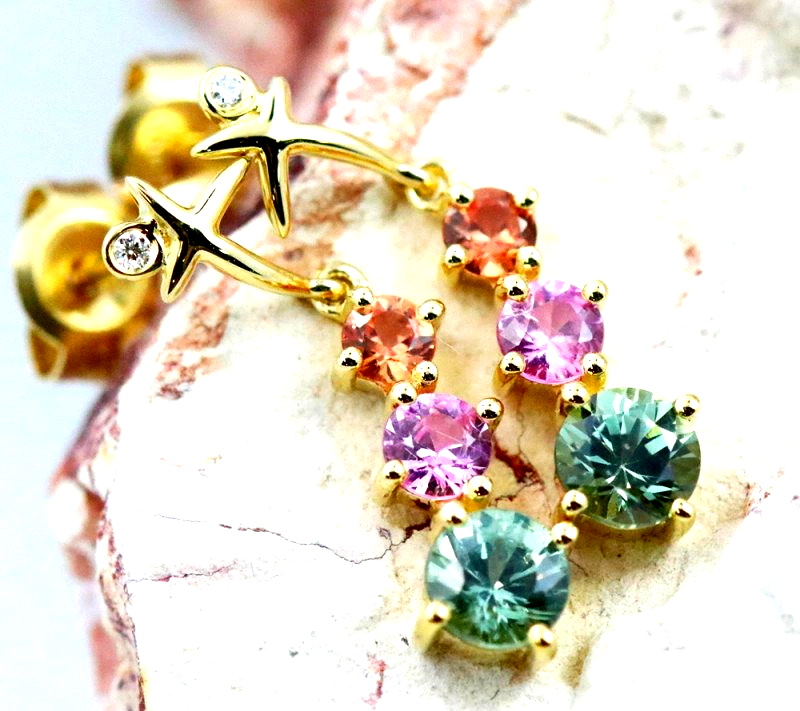 Pictured above: Gold earrings with orange, purple, and green sapphires with white accent diamonds
Pictured above: Gold earrings with orange, purple, and green sapphires with white accent diamonds
Smitten with September Birthstones?
Sapphires are one of the most enduring, legendary gemstones. Though their blue form is most popular, these crystals offer a range of hues and options perfect for any September birthstone jewelry!
Find traditional and alternative September birthstones from our hundreds of gemstones available!
Was this article helpful?
8 people found this article helpfulRoss Sedawie
- Written - 28th Aug 2016
- Edited - 11th Oct 2023
















